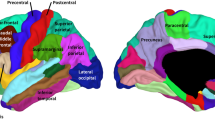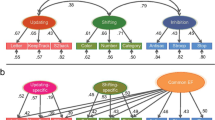Abstract
Background and aims
More than genetic and physical influences, different environmental stimuli affect brain reserve, and bilingualism is one example. In this study, effect of bilingual proficiency on older adult’s cognitive reserve was investigated.
Methods
Persian and English versions of the Word Association Test were used among 26 educated older adults with a mean age of 67.52 years who became bilingual in Persian–English early in life. Lexical memory and Bergen dichotic listening tests were performed.
Results
The bilingual proficiency score in all participants was within the range for early bilingualism. The Persian version of Word Association Test content validity index was 98.17 %. The inter-rater reliability for the Persian version of Word Association Test was 0.980, and that for the English version was 0.986. In addition, the intra-rater reliability for the Persian version was 0.857, and that for the English version was 0.954 (p < 0.001). There was significant correlation between the frequency of words expressed in the English Word Association Test and years for which English has been spoken as a second language (p ≤ 0.045). A significant correlation was observed between the bilingual proficiency score and lexical memory score (p < 0.043). Bilingual proficiency score also showed a significant correlation with the dichotic listening scores in all three non-forced, forced-right, and forced-left attention situations (p ≤ 0.045).
Conclusions
These results demonstrated the influence of bilingualism on shaping cognitive reserve in Persian–English bilingual older adults, representing linguistic experience-dependent neuroplasticity.

Similar content being viewed by others
References
Omidvar S, Jafari Z, Tahaei AA, Salehi M (2013) Comparison of auditory temporal resolution between monolingual Persian and bilingual Turkish-Persian individuals. Int J Audiol 52:236–241
McNealy K, Mazziotta JC, Dapretto M (2011) Age and experience shape developmental changes in the neural basis of language-related learning. Develop Sci 14:1261–1282
Costa A, Sebastian-Galles N (2014) How does the bilingual experience sculpt the brain? Nature Rev Neurosci 15:336–345
Bialystok E, Craik FI, Luk G (2012) Bilingualism: consequences for mind and brain. Trends Cognitive Sci 16:240–250
La Rue A (2010) Healthy brain aging: role of cognitive reserve, cognitive stimulation, and cognitive exercises. Clinics Geriatr Med 26:99–111
Stern Y (2002) What is cognitive reserve? Theory and research application of the reserve concept. J Int Neuropsychol Soc 8:448–460
Mortimer JA, Borenstein AR, Gosche KM, Snowdon DA (2005) Very early detection of Alzheimer neuropathology and the role of brain reserve in modifying its clinical expression. J Geriatr Psychiatry Neurol 18:218–223
Skoog I, Olesen PJ, Blennow K, Palmertz B, Jojnson SC, Bigler ED (2012) Head size may modify the impact of white matter lesions on dementia. Neurobiol Aging 33:1186–1193
Royle NA, Booth T, Valdés Hernández MC, Penke L, Murray C, Gow AJ et al (2013) Estimated maximal and current brain volume predict cognitive ability in old age. Neurobiol Aging 34:2726–2733
Perneczky R, Wagenpfeil S, Lunetta KL, Cupples LA, Green RC, Decarli C (2010) Head circumference, atrophy, and cognition: implications for brain reserve in Alzheimer disease. Neurology 75:137–142
den Heijer T, Geerlings MI, Hoebeek FE, Hofman A, Koudstaal PJ, Breteler MM (2006) Use of hippocampal and amygdalar volumes on magnetic resonance imaging to predict dementia in cognitively intact elderly people. Arc Gen Psychiat 63:57–62
Katzman R (1993) Education and the prevalence of dementia and Alzheimer’s disease. Neurology 43:13–20
Stern Y (2006) Cognitive reserve and Alzheimer disease. Alzheimer Dis Assoc Disord 20:112–117
Fratiglioni L, Paillard-Borg S, Winblad B (2004) An active and socially integrated lifestyle in late life might protect against dementia. Lancet Neurol 3:343–353
Bialystok E, Craik FI, Klein R, Viswanathan M (2004) Bilingualism, aging, and cognitive control: evidence from the Simon task. Psychol Aging 19:290–303
Chertkow H, Whitehead V, Phillips N, Wolfson C, Atherton J, Bergman H (2010) Multilingualism (but not always bilingualism) delays the onset of Alzheimer disease: evidence from a bilingual community. Alzheimer Dis Assoc Disord 24:118–125
Craik FI, Bialystok E, Freedman M (2010) Delaying the onset of Alzheimer disease: bilingualism as a form of cognitive reserve. Neurology 75:1726–1729
Gollan TH, Salmon DP, Montoya RI, Galasko DR (2011) Degree of bilingualism predicts age of diagnosis of Alzheimer’s disease in low-education but not in highly educated Hispanics. Neuropsychologia 49:3826–3830
Kave G, Eyal N, Shorek A, Cohen-Mansfield J (2008) Multilingualism and cognitive state in the oldest old. Psychol Aging 23:70–78
Crinion J, Turner R, Grogan A, Hanakawa T, Noppeney U, Devlin JT et al (2006) Language control in the bilingual brain. Science (New York, NY) 312:1537–1540
Stein M, Federspiel A, Koenig T, Wirth M, Strik W, Wiest R et al (2012) Structural plasticity in the language system related to increased second language proficiency. Cortex 48:458–465
Lambert WE (1956) Developmental aspects of second language acquisition: I. Associational fluency, stimulus provocativeness and word order influence. J Soc Psychol 43:83–89
Lee H, Kim KH (2011) Can speaking more languages enhance your creativity? Relationship between bilingualism and creative potential among Korean American students with multicultural link. Pers Individ Dif 50:1186–1190
Peal E, Lambert W (1962) The relation of bilingualism to intelligence. Psychol Monogr 76:1–23
Hugdahl K (2011) Fifty years of dichotic listening research—still going and going and. Brain Cogn 76:211–213
McArdel R, Hanath-Chisolm T (2009) Speech audiometry. In: Katz J, Medwetsky L, Burkard R, Hood LJ (eds) Handbook of Clinical Audiology, 3rd edn. Williams and Wilkins, Baltimore, pp 64–80
Folstein MF, Folstein SE, McHugh PR (1975) “Mini-mental state”. A practical method for grading the cognitive state of patients for the clinician. J Psychiatr Res 12:189–198
Karami A (2008) Persian Version of the Wechsler adult intelligence scale, 3rd edn. Tehran, Ravansanji
BijanKan M (2012) Frequency dictionary based on the textual corpus of today Persian. Tehran University, Tehran
McGartland R (2005) Content validity. Encyclopedia of social measurement. Elsevier Inc, Pittsburgh
Lezak MD, Howieson DB, Loring DW (2004) Neuropsychological assessment, 4th edn. Oxford University Press, New York
Hugdahl K (2003) Dichotic listening in the study of auditory laterality. In: Hugdahl K, Davidson RJ (eds) The asymmetric brain. The MIT Press, Cambridge, pp 441–475
Abutalebi J, Canini M, Della Rosa PA, Sheung LP, Green DW, Weekes BS (2014) Bilingualism protects anterior temporal lobe integrity in aging. NeurobiolAging 35:2126–2133
Antoniou M, Gunasekera GM, Wong PC (2013) Foreign language training as cognitive therapy for age-related cognitive decline: a hypothesis for future research. Neurosci Biobehav Rev 37:2689–2698
Gold BT, Johnson NF, Powell DK (2013) Lifelong bilingualism contributes to cognitive reserve against white matter integrity declines in aging. Neuropsychologia 51:2841–2846
Semel E, Wiig EH, Secord WA (1992) Clinical evaluation of language fundamentals. Psychological Corporation-Harcourt Brace & Co, San Antonio
Schlegel AA, Rudelson JJ, Tse PU (2012) White matter structure changes as adults learn a second language. J Cognitive Neurosci 24:1664–1670
Rodriguez-Fornells A, Cunillera T, Mestres-Misse A, de Diego-Balaguer R (2009) Neurophysiological mechanisms involved in language learning in adults. Philos Trans R Soc Lond B Biol Sci 364:3711–3735
Hull R, Vaid J (2007) Bilingual language lateralization: a meta-analytic tale of two hemispheres. Neuropsychologia 45:1987–2008
Acknowledgments
This paper is a result of a research project that has been approved by Iran University of Medical Sciences, contract number 91-03-32-19154. The cooperation of all participants in this study is greatly appreciated.
Conflict of interest
The authors declare that they have no competing interest.
Author information
Authors and Affiliations
Corresponding author
Rights and permissions
About this article
Cite this article
Jafari, Z., Esmaili, M., Toufan, R. et al. Bilingual proficiency and cognitive reserve in Persian–English bilingual older adults. Aging Clin Exp Res 27, 351–357 (2015). https://doi.org/10.1007/s40520-014-0288-x
Received:
Accepted:
Published:
Issue Date:
DOI: https://doi.org/10.1007/s40520-014-0288-x




